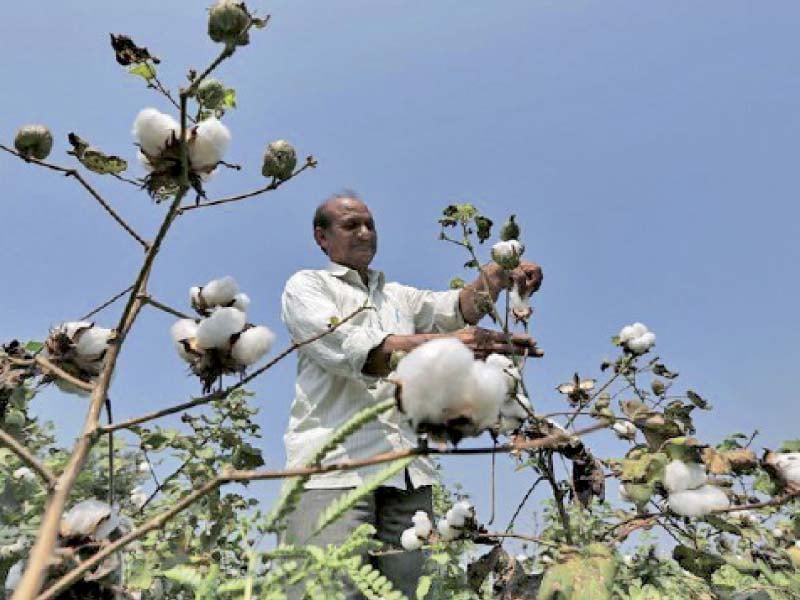
The current spell of widespread rainfall has been largely beneficial for the standing crops in the fields - including major ones like cotton, sugarcane, paddy (raw rice) and maize in Pakistan. The moderate showers may help improve the agriculture economy and increase its share in the challenging gross domestic product (GDP) in the current fiscal year 2020-21.
Experts and growers said cotton and maize are rain-sensitive crops. The current downpour is, however, moderate and not too heavy. So it is yet beneficial. Moreover, sugarcane and paddy are water-resilient crops. Moderate and slightly heavy rains can increase their output. Extremely heavy rains can be destructive, but this is not the case as per the rainfall forecasts.
Questioning the hue and cry regarding the rainy season, Sindh Abadgar Board (SAB) Vice President Syed Mahmood Nawaz Shah told The Express Tribune, “The forecast reports we received do not suggest heavy rainfall and flooding in near future. They are yet favourable.”
“The rains would prove beneficial for cotton,” Pakistan Cotton Ginners’ Association (PCGA) former vice chairman Prem Chand Khiyatni said. “There are light rains on the cotton belt in Sindh. The soil has absorbed the rainwater instead of standing in the fields. A similar quantum of rains is needed to take good output of cotton this season.”
Meanwhile, Agri Forum Pakistan (AFP) official Dr Ibrahim Mughal said there are a few reports of cotton damage due to the current raining in Punjab. The province’s share in total production of all the major crops stands at around 65-70% of Pakistan.
Khiyatni said more rainfall of the same quantum may improve cotton output by 10-15%.
Cotton is a major cash-crop of the country. Unfortunately, the country has continued to produce less and low quality cotton for the past four to five years mainly due to non-availability of quality seeds, he said.
The government has set the target of cotton production at 11 million bales (of 170kg each) for FY21. The country produced around 8.5 million bales against total requirement of around 15-16 million bales from textile exporters in the previous year (FY20).
Water was available in good quantity at the start of the current Kharif (summer) season. However, the rainfall has ensured sufficient availability, especially in the water canals’ tail-end farming areas.
“Farmers in the district Badin (one of the tail-end areas) had staged protest against non-availability of water outside the local press club about 10 days ago. The rainfall should have irrigated their crops these days,” Shah said.
“The rainfall has advanced crops production by 30-40 days,” he said, adding that this is the peak summer season when water requirements and evaporation both stand at a high rate. “The rains have washed away pest and other diseases and health for leaves as well,” he said.
He added that sugarcane and paddy are water-resilient crops. “Availability of more water would be good for them. Paddy can grow better with 2.5-3 inch rainfall and sugarcane with 8-10 inch water,” he said.
“The sugarcane yield may improve by 10-20% (this season) depending upon the quantum rainfall,” he said.
Pakistan produces sugarcane and paddy in surplus, which is usually exported to earn foreign exchange.
Paddy crop is expected to be better than the last year. Farmers faced extreme temperature issue, which hurt the crop last year. “This issue has yet not come again and hopefully the rains will help taking better output this year,” he said.
On the flipside, the rainfall may slightly impact cotton ready to be picked. Farmers take multiple picking of cotton in each season spreading up two to three months.
Moreover, farmers have picked almost all the grown dates this season. The rainfall, however, may hurt the remaining dates on the trees. “Dates are highly sensitive to rain,” he said.
Mughal added that the rainfall may prove highly dangerous for cotton. “The rainfall has started damaging cotton and if the spell of the rainfall is extended it can prove to be devastating for the crop,” he said.
“The months of August and September are highly crucial for cotton production. These are the months which generate estimate for the total cotton production in the season,” he said.
The rainfall would, however, improve paddy production by about half a million to 6.5 million ton and sugarcane by five million ton to 65 million tons this year in Pakistan. “The production would improve as farmers are making more efforts to take high productions,” he said.
Published in The Express Tribune, August 8th, 2020.
Like Business on Facebook, follow @TribuneBiz on Twitter to stay informed and join in the conversation.



1731325890-0/trump-(24)1731325890-0-165x106.webp)













COMMENTS
Comments are moderated and generally will be posted if they are on-topic and not abusive.
For more information, please see our Comments FAQ